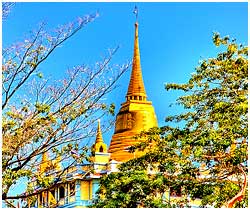Today, the temple is spectacular in its own rights. Nevertheless, what marks its unmatched significance is the glittering Golden Mount, an artificial hill constructed under the regime of King Rama III. Before the hill was erected, the king tried to build a chedi (stupa) here. However, the soft soil failed to hoist the structure and collapsed with the weight. Therefore, strong piles of mud and bricks were stacked to sustain its burden. Soon after, during King Rama IV's regime, teak logs were added to prop up the hill, along with a chedi to top the structure.
 However, the chedi, as it stands today, saw erection only after a few
years, during the rule of King Rama V. He interred the mount with the
first holy relics of Buddha in the year 1877. The second interment took
place in 1899, after Lord Curzon presented Rama V with Buddha relics
unearthed from the Nepalese border. His Majesty encased these holy
remnants in a bronze pagoda and installed it on top of the Golden Mount.
Therafter, the Wat Saket emerged as a source of utmost awe and
veneration among the Buddhists.
However, the chedi, as it stands today, saw erection only after a few
years, during the rule of King Rama V. He interred the mount with the
first holy relics of Buddha in the year 1877. The second interment took
place in 1899, after Lord Curzon presented Rama V with Buddha relics
unearthed from the Nepalese border. His Majesty encased these holy
remnants in a bronze pagoda and installed it on top of the Golden Mount.
Therafter, the Wat Saket emerged as a source of utmost awe and
veneration among the Buddhists.The towering chedi of the temple, enclosed with glittery gold mosaic tiles, is the most revered site. It crowns the rooftop terrace and calls for a steep climb of 318 steps. On reaching the terrace, one can not only have a close view of the mount, but also have an aerial view of the breathtaking vistas spread below, including the Temple of the Emerald Buddha, the Democracy Monument and glimpses of Bangkok's business districts. Wat Saket temple invites many visitors with its beauty and religious significance, more often than not, during its popular temple fair held in October/ November.



